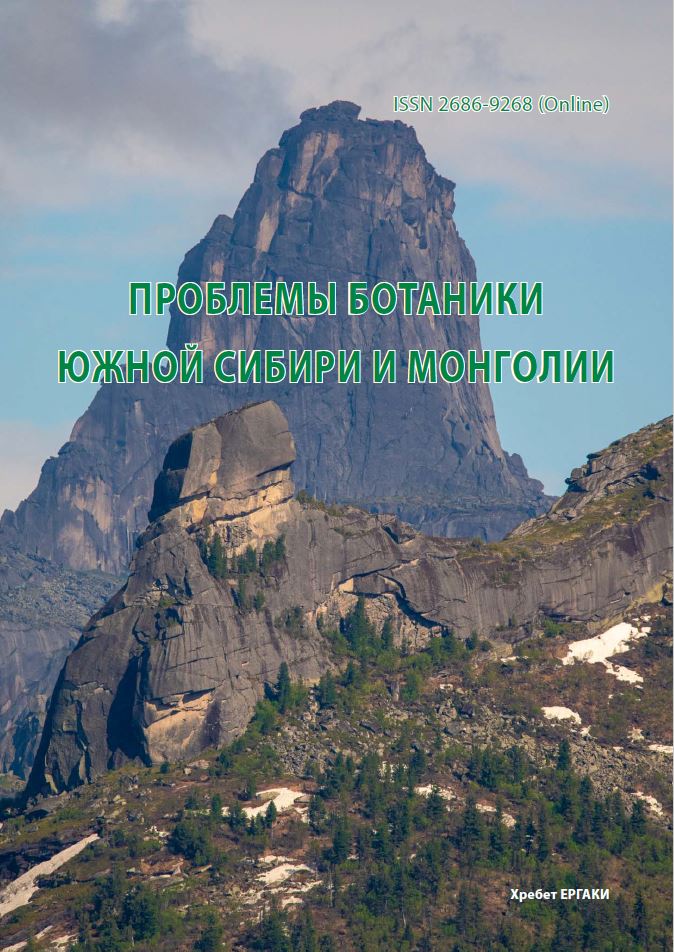Comparative analysis of genomes of six species of Hedysarum L. (Fabaceae) by the rapidGISH technique
УДК 575.174.015.3:575.853:576.316.2
Abstract
A comparative analysis of genomes of six Hedysarum species was carried out using the rapid genomic in situ hybridization (rapidGISH) technique, which makes it possible to identify common highly repetitive DNA sequences, and also shows the patterns of their distribution on chromosomes of the studied species. Dispersed localization of genomic DNA of H. flavescens (sect. Hedysarum) was found on chromosomes of H. alpinum and H. theinum (both belonged to sect. Hedysarum). On chromosomes of H. neglectum from the section Hedysarum, clustered hybridization signals of genomic DNA of H. flavescens were observed. The localization of H. alpinum genomic DNA was found along the all chromosomes of H. flavescens and H. theinum. On chromosomes of H. grandiflorum and H. dahuricum (both from sect. Multicaulia), small clustered and dispersed hybridization signals of genomic DNA of H. flavescens and H. alpinum were found. Thus, in the studied species, common highly repetitive DNA sequences of different types of their chromosome organization were revealed. Our findings indicate the presence of common origin of the species from the sections Hedysarum and Multicaulia with different degree of their relationship.
Downloads
Metrics
References
айтенов М. С. Родовой комплекс флоры // Флора Казахстана: В 2-х т. Т. 2. - Алматы: Гылым, 2001. - 280 с.
Кукушкина Т. А., Высочина Г. И., Карнаухова Н. А., Селютина И. Ю. Содержание мангиферина и суммы ксантонов в растениях некоторых дикорастущих и интродуцированных видов Hedysarum (Fabaceae) // Раст. Ресурсы, 2011. - Вып. 1. - С. 99-105.
Курбатский В. И. Hedysarum L. // Флора Сибири. Т. 9. - Новосибирск: Наука, 1994. - С. 153-165.
Amosova A. V., Bolsheva N. L., Samatadze T. E., Twardovska M. O., Zoshchuk S. A., Andreev I. O., Badaeva E. D., Kunakh V. A., Muravenko O. V. Molecular cytogenetic analysis of Deschampsia antarctica Desv. (Poaceae), Maritime Antarctic // PLoS One, 2015. - 10(9): e0138878. DOI: 10.1371/journal.pone.0138878
Arslan E., Ertugrul K., Tugay O., Dural H. Karyological studies of the genus Onobrychis Mill. and the related genera Hedysarum L. and Sartoria Boiss. and Heldr. (Fabaceae, Hedysareae) from Turkey // Caryologia, 2012. - Vol. 65, № 1. -P. 11-17. DOI: 10.1080/00087114.2012.678079
Choi B. H., Ohashi H. Generic criteria and an infrageneric system for Hedysarum and related genera (Papilionoideae-Leguminosae) // Taxon, 2003. - Vol. 52. - P. 567-576. DOI: 10.2307/3647455
Dong Y., Tang D., Zhang N., Li Y., Zhang C., Li L., Li M. Phytochemicals and biological studies of plants in genus Hedysarum // Chem. Cent. J., 2013. - 7:124. DOI: 10.1186/1752-153X-7-124
Duan L., Wen J., YangX., Liu P. L., Arslan E., Ertugrul K., ChangZ. Y. Phylogeny of Hedysarum and tribe Hedysareae (Leguminosae: Papilionoideae) inferred from sequence data of ITS, matK, trnL-F and psbA-trnH // Taxon, 2015. - Vol. 64, is. 1. - P. 49-64. DOI: http://www.jstor.org/stable/24639244
Liu P. L., Wen J., Duan L., Arslan E., Ertugrul K., Chang Z. Y. Hedysarum L. (Fabaceae: Hedysareae) is not monophyletic - Evidence from phylogenetic analyses based on five nuclear and five plastid sequences // PLoS ONE, 2017. - 12:e0170596. DOI:10.1371/journal.pone.0170596
Liu Yi., Yu-Ying Zhao, Guang-Zhong Tu, Hu-Biao Chen Flavonoids of the roots of Hedysarum kirghisorum // Biochemical Systematics and Ecology, 2005. - Vol. 33, is. 8. - P. 809-812. DOI: 10.1016/j.bse.2005.01.007
Nafisi H., Kazempour-Osaloo S., Mozaffarian V., Schneeweiss G. M. Molecular phylogeny and divergence times of the genus Hedysarum (Fabaceae) with special reference to section Multicaulia in Southwest Asia // Plant. Syst. Evol., 2019. - Vol. 305. - P. 1001-1017. DOI: 10.1007/s00606-019-01620-3
Rogers S. O., Bendich A. J. Extraction of DNA from milligram amounts of fresh, herbarium and mummified plant tissues// Plant Mol. Biol., 1985. - Vol. 5. - P. 69-76.
Yurkevich O. Y., Kirov I. V., Bolsheva N. L., Rachinskaya O. A., Grushetskaya Z. E., Zoschuk S. A., Samatadze T. E., Bogdanova M. V., Lemesh V. A., Amosova A. V., Muravenko O. V. Integration of physical, genetic, and cytogenetic mapping data for Cellulose synthase (CesA) genes in flax (Linum usitatissimum L.) // Front. Plant Sci., 2017. - 8:1467. DOI: 10.3389/fpls.2017.01467



